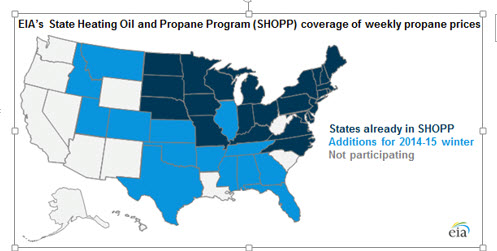WASHINGTON, Oct. 22, 2014 – The Energy Information Administration is monitoring weekly propane price data in more states after prices skyrocketed last winter.
EIA began monitoring in 14 new states – Alabama, Arkansas, Colorado, Florida, Georgia, Idaho, Illinois, Kansas, Mississippi, Montana, Oklahoma, Tennessee, Texas and Utah – on Oct. 16 and said the monitoring will continue until March. The agency said it will also aggregate propane prices for the U.S. Gulf Coast and Rocky Mountain regions.
With the additional states, the State Heating Oil and Propane Program (SHOPP) will now cover 85 percent of households using propane as a heating fuel, up from 56 percent. SHOPP is an EIA program that monitors average residential propane costs, wholesale propane prices, and the overall U.S. propane supply.

The data will be accessible on an interactive web page that allows users to see price breakdowns on a state-by-state and national basis. EIA said the nature of the propane market makes things like SHOPP a necessity to those who rely on propane.
“Unlike retail natural gas and electricity, which are both provided through utility companies, retail heating oil and propane are sold by independent dealers,” EIA said on its website. “Dealers and their customers face considerable supply and price uncertainty, such as during this past winter when extreme weather drove up demand for heating fuels, depleting inventories and increasing prices.”
Propane usage typically follows a wave pattern that spikes during winter months. The combination of cooling temperatures and grain harvest across the country will soon put a pinch on propane supplies. Many homes use propane-fueled heaters and many farmers and elevator operators use propane to fuel machines that dry grain deemed too wet for shipping or long-term storage. SHOPP data says the propane supply numbers show a greater supply than previous five-year ranges for the week ending October 10, so the shortages experienced last winter could potentially be avoided if the fuel can be successfully transported.
SHOPP will now monitor all but 12 states: Alaska, Arizona, California, Colorado, Hawaii, Louisiana, Nevada, New Mexico, Oregon, South Carolina, West Virginia, and Washington. The program included 24 states prior to this season, the majority of which were in the Midwest or Northeast.
#30
For more news, go to www.agri-pulse.com.
